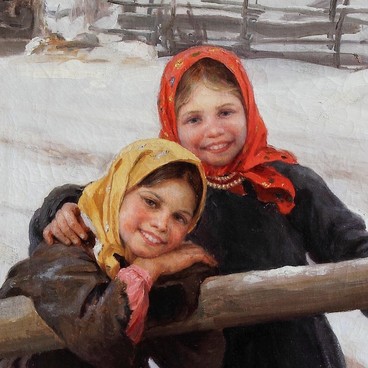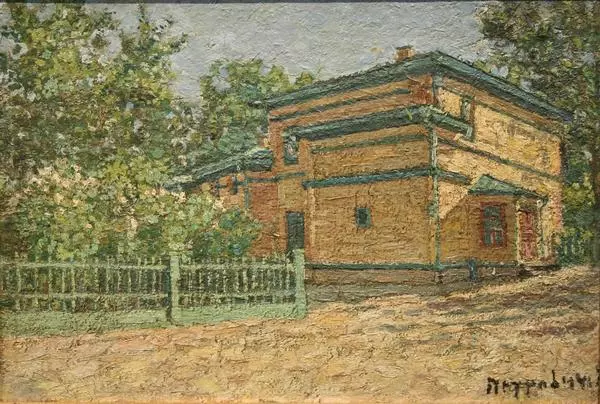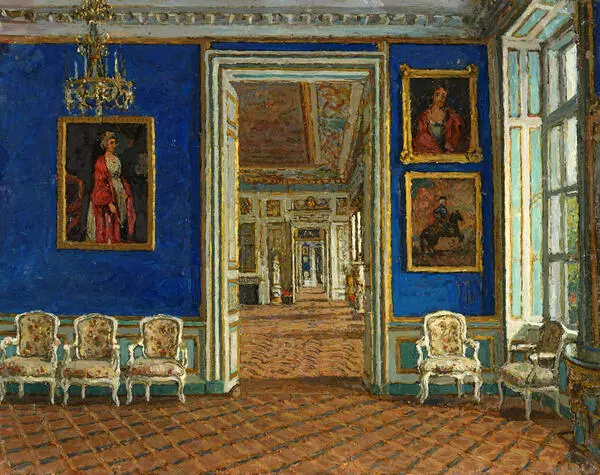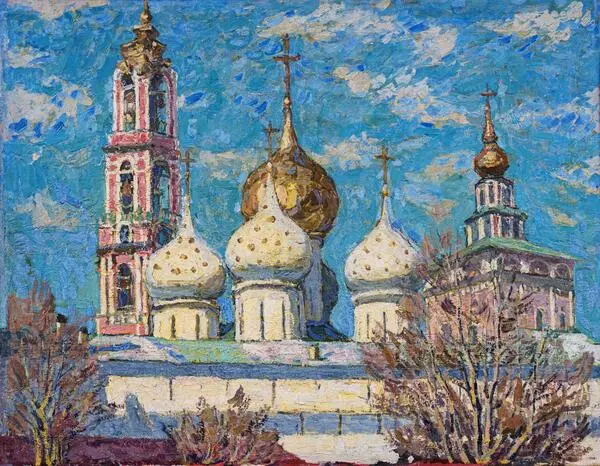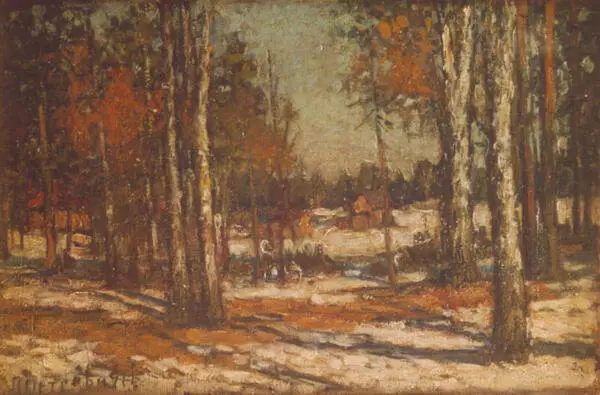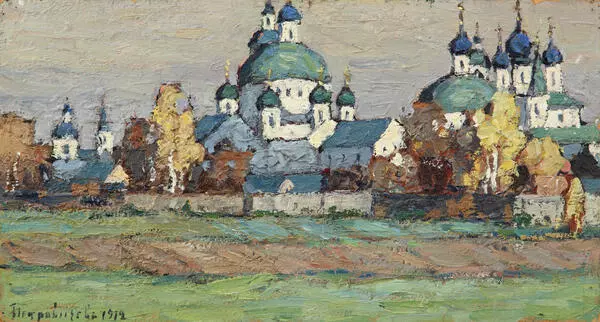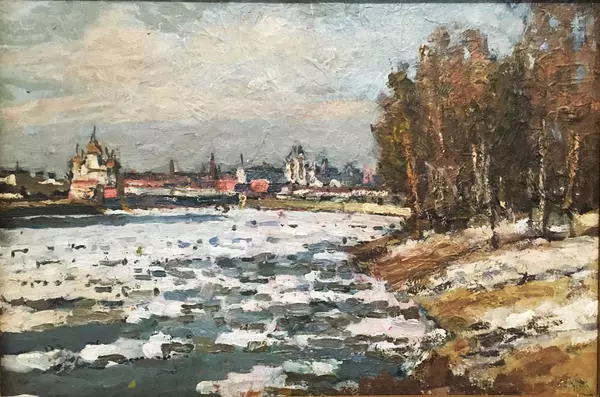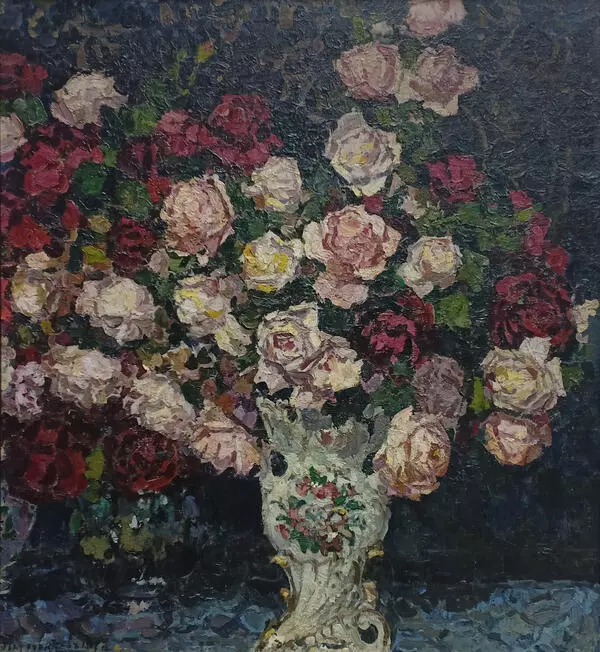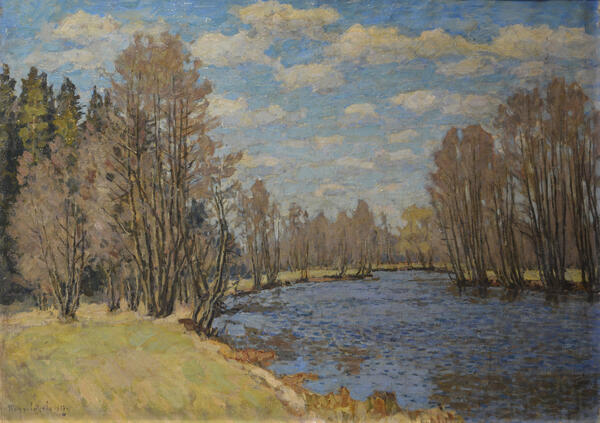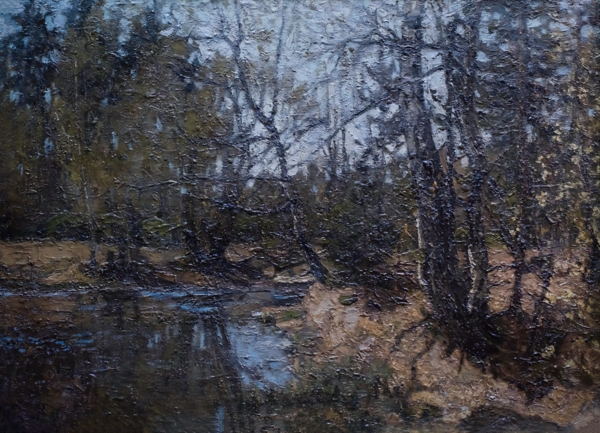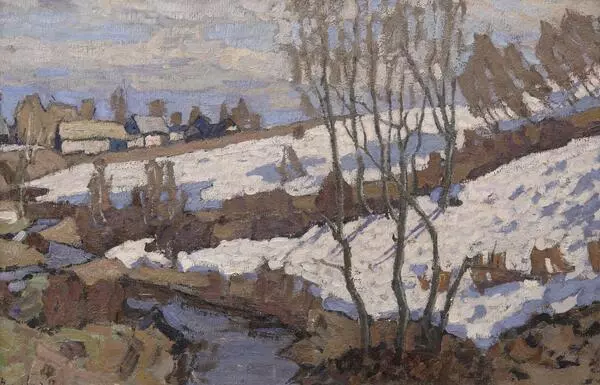Petr Petrovichev painted ‘In the Church of the Savior at Nereditsa near Novgorod’ in 1910. The author managed to portray the ancient frescoes painted in the church interior in the XII century. During the Great Patriotic War the church was destroyed and its interior decoration remained only on paintings and photographs.
The center of the composition is one of the church’s walls with frescoes. Parts of ancient painting fell off in places and the author did not try to mask it — on the contrary, he emphasized empty spaces on pillars with light strokes. The master painted the church at the time of the day when bright sun was shining through its windows. The sun rays fell on window apertures and left diagonal streaks of light. He portrayed this lighting in his painting.
Fine art experts noted that Petr Petrovichev always closely followed nature. He portrayed specific significant sites in exactly the same condition he saw them. “Petrovichev”s art has no hint of pasticcio, he is not striving to reconstruct history or add to the interior his view of the distant past”, — wrote Vladimir Rudnev in his book “Petr Ivanovich Petrovichev. Life and Creative Work'.
Ancient church researcher Nikolai Pokrovsky described the church frescos palette as follows: “The paints are quite pale; in the middle part of the church they are brighter and thicker than in the altar”. The painter managed to convey this obscurity. He painted the frescos backgrounds on white size with various shades of light blue that matched organically with brownish and ochre colors of the figures of saints.
Petr Petrovichev started painting these subjects for a reason — in his teenage years he worked as icon painter and restorer in the Rostov Museum of Ecclesiastical Antiquities. He was noted there by Vasily Vereschagin who helped him enter the Moscow School of Arts, Sculpture and Architecture in 1892. At first Petrovichev did not stand out among his peers but with time his mastery was refined and his teacher Isaac Levitan even showed his works as examples to other students. “Here, look how one should paint, how simple and genuine it is, — this is nature itself. This is what is needed in the art of painting!”, — remembered Petrovichev later the words of his mentor.
Although Petr Petrovichev is most known for his lyrical landscapes, he painted interiors of ancient buildings as often. He was attracted to the interior decoration of churches and old mansions and created several paintings from different angles in his favorite places. Such was his work in the Church of the Savior at Nereditsa. In addition to the painting shown here, he painted two more interiors on the choir loft (this is the name of upper open galleries or balconies inside churches). It is important that Petrovichev never painted genre scenes in his landscapes or interiors. For him the nature and architecture were not a background emphasizing some other main idea: he painted nature, churches and mansions per se.
The center of the composition is one of the church’s walls with frescoes. Parts of ancient painting fell off in places and the author did not try to mask it — on the contrary, he emphasized empty spaces on pillars with light strokes. The master painted the church at the time of the day when bright sun was shining through its windows. The sun rays fell on window apertures and left diagonal streaks of light. He portrayed this lighting in his painting.
Fine art experts noted that Petr Petrovichev always closely followed nature. He portrayed specific significant sites in exactly the same condition he saw them. “Petrovichev”s art has no hint of pasticcio, he is not striving to reconstruct history or add to the interior his view of the distant past”, — wrote Vladimir Rudnev in his book “Petr Ivanovich Petrovichev. Life and Creative Work'.
Petr Petrovichev, second interior of the Church of the Savior at Nereditsa near Novgorod, 1910. Part of the dome drum can be seen in the top part of the painting. Petr Petrovichev, second interior of the Church of the Savior at Nereditsa near Novgorod, 1910. Part of the dome drum can be seen in the top part of the painting.
Ancient church researcher Nikolai Pokrovsky described the church frescos palette as follows: “The paints are quite pale; in the middle part of the church they are brighter and thicker than in the altar”. The painter managed to convey this obscurity. He painted the frescos backgrounds on white size with various shades of light blue that matched organically with brownish and ochre colors of the figures of saints.
Petr Petrovichev started painting these subjects for a reason — in his teenage years he worked as icon painter and restorer in the Rostov Museum of Ecclesiastical Antiquities. He was noted there by Vasily Vereschagin who helped him enter the Moscow School of Arts, Sculpture and Architecture in 1892. At first Petrovichev did not stand out among his peers but with time his mastery was refined and his teacher Isaac Levitan even showed his works as examples to other students. “Here, look how one should paint, how simple and genuine it is, — this is nature itself. This is what is needed in the art of painting!”, — remembered Petrovichev later the words of his mentor.
Although Petr Petrovichev is most known for his lyrical landscapes, he painted interiors of ancient buildings as often. He was attracted to the interior decoration of churches and old mansions and created several paintings from different angles in his favorite places. Such was his work in the Church of the Savior at Nereditsa. In addition to the painting shown here, he painted two more interiors on the choir loft (this is the name of upper open galleries or balconies inside churches). It is important that Petrovichev never painted genre scenes in his landscapes or interiors. For him the nature and architecture were not a background emphasizing some other main idea: he painted nature, churches and mansions per se.
Ancient church researcher Nikolai Pokrovsky described the church frescos palette as follows: “The paints are quite pale; in the middle part of the church they are brighter and thicker than in the altar”. The painter managed to convey this obscurity. He painted the frescos backgrounds on white size with various shades of light blue that matched organically with brownish and ochre colors of the figures of saints.
Petr Petrovichev started painting these subjects for a reason — in his teenage years he worked as icon painter and restorer in the Rostov Museum of Ecclesiastical Antiquities. He was noted there by Vasily Vereschagin who helped him enter the Moscow School of Arts, Sculpture and Architecture in 1892. At first Petrovichev did not stand out among his peers but with time his mastery was refined and his teacher Isaac Levitan even showed his works as examples to other students. “Here, look how one should paint, how simple and genuine it is, — this is nature itself. This is what is needed in the art of painting!”, — remembered Petrovichev later the words of his mentor.
Although Petr Petrovichev is most known for his lyrical landscapes, he painted interiors of ancient buildings as often. He was attracted to the interior decoration of churches and old mansions and created several paintings from different angles in his favorite places. Such was his work in the Church of the Savior at Nereditsa. In addition to the painting shown here, he painted two more interiors on the choir loft (this is the name of upper open galleries or balconies inside churches). It is important that Petrovichev never painted genre scenes in his landscapes or interiors. For him the nature and architecture were not a background emphasizing some other main idea: he painted nature, churches and mansions per se.


